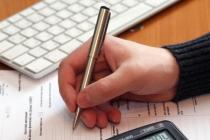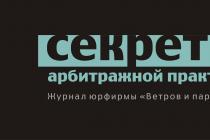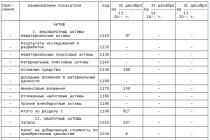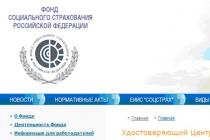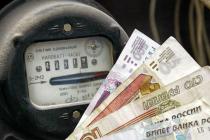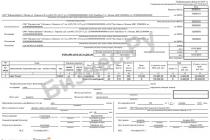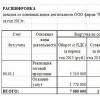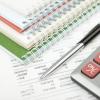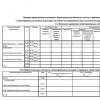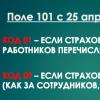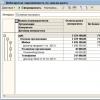Instruction
Before proceeding with the calculation of the average annual cost of fixed assets, please note that they distinguish between their initial, replacement and residual value. The initial cost reflects the level of costs associated with the acquisition or creation of fixed assets. The initial cost during the operation of the property does not change, with the exception of cases of completion, reconstruction or partial liquidation. The replacement cost corresponds to the cost of acquiring or building similar property, plant and equipment under market conditions. To determine the replacement cost, revaluate fixed assets, taking into account indexation or market prices. Residual value is the original (replacement) cost minus depreciation.
You must understand that the calculation of the average annual cost of fixed assets is a necessity due to the change in their physical and cost value during the year. An enterprise can acquire new property and write off worn-out property. Therefore, the cost of fixed assets at the beginning of the year will be different from their cost at the end of the year, which you can calculate as follows:
From the first (year) \u003d From the first (year) + From the input - From the choice, where From the first (year) - the initial cost of fixed assets at the end of the year; From the first (n.g.) - the initial cost of fixed assets at the beginning of the year; C input - the cost of fixed assets put into operation during the year; With vyb - the cost of fixed assets retired during the year.
You can calculate the average annual cost of fixed assets in several ways. The simplest of them is the determination of the half-sum of the balances of fixed assets at the beginning and end of the year:
C cf \u003d (C first (n.g.) + C first (c.g.)) / 2.
The calculation in this way does not give a very accurate result, since the input and disposal of fixed assets during the year is uneven.
For a more accurate calculation, use the following formula:
C cf = C first (n.y.) + M1/12 x C input - M2/12 x C select, where M1 and M2 are the number of full months from the date of input (disposal) of fixed assets.
The most reliable is the method of calculating the average annual cost of fixed assets according to the chronological average formula:
C cf \u003d [ (C1 (n.m.) + C1 (c.m.)) / 2 + (C2 (n.m.) + C2 (c.m.)) / 2 ... + (Ci (n.m.)) m.) +Сi (c.m.))/2]/12, where Сi (n.m.) is the cost of each fixed asset at the beginning of the month, Сi (c.m.) is the cost of each fixed asset at the end of the month.
Tip 2: How to Calculate the Average Annual Property Value
Take into account the month of input and output of fixed assets when calculating the average annual cost. To do this, adjust the cost of the introduced and retired fixed assets by the number of full months that have passed since the introduction and introduction of the object, divided by 12.
After that, add the initial cost at the beginning of the year with the adjusted cost of the introduced fixed assets and subtract the new value of the cost of retired fixed assets from the sum. However, the most accurate average annual cost can be obtained if the average monthly cost is taken into account in the calculation, which is defined as the arithmetic average of the cost at the beginning and at the end of the month.
Tip 5: How to determine the residual value of fixed assets
The cost of fixed assets of the enterprise, calculated taking into account the depreciation of fixed assets, is called residual. Methods for calculating this characteristic are elements of a special measurement system called the assessment of fixed assets.

Instruction
The term "fixed assets" is used in the preparation of accounting and tax reporting of the organization. These are the tangible assets of the enterprise, expressed in monetary terms, which are involved in the production of goods and the provision of services with a service life of up to a year. The assets of the enterprise are called fixed assets.
Fixed assets are considered as natural means of labor (land, water) and artificial (tools, equipment, devices and other technical devices). Artificial or technical means of labor have a certain service life and wear out over time.
To reduce the wear and tear of equipment (repair, preventive maintenance), depreciation deductions are allocated from the company's budget, which are considered production costs.
The residual value of the company's fixed assets is calculated as the difference between the initial cost of equipment and the amount of depreciation for a certain reporting period (usually a year).
Depreciation is calculated in several ways: linear, declining balance, depreciation by the sum of numbers of years of useful life, depreciation in proportion to the volume of production.
The straight-line method involves the calculation based on the initial cost of the equipment and depreciation rates according to the useful life. The useful life is determined by the Classification of property, plant and equipment.
The reducing balance method takes into account the residual value of the object at the beginning of the reporting period and depreciation rates, taking into account a coefficient not exceeding 3. Each company sets its own coefficient values.
According to the method of writing off the cost by the sum of the numbers of years of the useful life, the depreciation amount is calculated at the historical cost and the ratio between the number of years remaining until the end of the useful life and the number of past years of useful life of the fixed asset.
The method of writing off the cost in proportion to the volume of production is mainly used in the calculation of depreciation deductions for the means of labor for the extraction of natural raw materials. The amount of depreciation of fixed assets is calculated as the ratio of the value of fixed assets to the volume of manufactured products.
Related videos
Tip 6: How to determine the average annual value of a property
The calculation of the average annual cost is required to determine the property tax. Organizations and private entrepreneurs are required to submit tax declarations to the regulatory authority at the end of the calendar year. According to Art. 375 of the Tax Code of the Russian Federation (TC RF), average annual or average price immovable property calculated as its determinable tax base. In turn, the procedure for calculating the tax base is explained in Art. 376 of the Tax Code of the Russian Federation.

You will need
- - the tax code of the Russian Federation;
- - accounting data for the year
Instruction
property make a list of all real estate that is on the balance sheet of the organization as fixed assets. Average annual price immovable property calculated for each object. If the organization has separate divisions, then the average annual price immovable property for them is determined separately.
Determine when calculating price property for the tax period. Those who first undertake the calculation of the average annual cost property, often confuse the tax period with the reporting period, which leads to errors. Art. 379 of the Tax Code indicates that a calendar year (12 months) is considered a tax period, and the first quarter of the year, the first half of the year and nine months of the calendar year are considered reporting periods.
To determine the average annual value of real estate property take the residual price each object reflected in the accounting data of the organization. According to chapter 30 of the Tax Code of the Russian Federation, in order to determine the average annual price property for the tax period it is necessary to add the residual price(OS) of each immovable property on the first day of each month of the tax period and on the last day of the tax period. For example: average price property for 2011 will consist of the cost property January 1, February 1, March 1, April 1, May 1, June 1, July 1, August 1, September 1, October 1, November 1, December 1 and December 31.
According to the general rule of tax accounting, divide the resulting number by the number of months in the tax period (since the tax period is a year, their number is 12), increased by one. General formula for calculating the average annual cost property is as follows: (Jan 1 OS + Feb 1 OS + March 1 OS + April 1 OS, May 1 OS, June 1 OS, July 1 OS, Aug 1 OS, Sep 1 OS, Oct 1 OS, Nov 1 OS, December 1 OS and Dec 31 OS) : (12+1 )
The purpose of calculating the initial cost of production is to analyze the efficiency of the use of resources in production. Based on this data, plans are developed to optimize costs and save. A rather extensive assessment of all areas of production is used: the organization of labor, the level of capacities and technologies, the feasibility of spending fixed assets, etc.
As a rule, in any company there is some structure of initial cost, which reflects certain types of costs. Such a classification according to various calculation items allows you to identify the ratio of costs in areas and analyze the degree of their influence on the initial price (without extra charge) of the goods. The purpose of such an analysis is to minimize costs and increase profits.
Most industrial enterprises calculate two values: shop initial cost and full initial cost. The first consists of the following seven calculation items:
Raw materials and basic materials;
Electricity for equipment operation;
Salary of the main production staff (workers);
Additional payments to the main staff for overtime, night shifts or holidays;
Social Security contributions;
Depreciation and additional materials for the operation of the equipment (oil, cooling liquid, lubricants, etc.);
Other production costs for the shop.
Tip 8: Accounting for fixed assets. Admission and revaluation
In carrying out activities, some heads of organizations use fixed assets. These assets include buildings, machinery, equipment, and more. In accounting, transactions made with property should be reflected in account 01.

What are fixed assets
Fixed assets are assets that have a useful life of more than one year. They are not intended for resale and have a tangible form, that is, they can be seen, touched.
Fixed assets are classified into production and non-production. The first group includes machines, equipment (machines, for example), buildings. The second group includes those assets that do not take part in production, this can include kindergartens, clinics, etc.
There are also active and passive means. Active take a direct part in production, this includes machine tools, equipment. Buildings are passive.
Receipt of fixed assets
Property can come to the organization from various sources, for example, from the founders, as a result of a purchase, under a gratuitous contract, etc. Commissioning must be carried out on the basis of the order of the manager. After signing it, the accountant draws up an act of acceptance and transfer of the asset (form No. OS-1, form No. OS-1a or form No. OS-1b).
Also, an inventory card must be entered for the fixed asset (form No. OS-6, form No. OS-6a or form No. OS-6b) and an inventory number assigned.
Postings for the receipt of fixed assets
In accounting, commissioning should be reflected as follows:
If the property is received from the founders:
D75.1 K80 - reflects the debt of the founders on deposits;
D08 K75.1 - assets received on account of a contribution to the management company;
D01 K08 - assets are put into operation.
If the property is purchased from suppliers:
D08 K60 - funds paid to the supplier for fixed assets;
D08 K76 (60.23) - the amount of expenses for the delivery of fixed assets is reflected;
D01 K08 - the fixed asset was put into operation.
Valuation of fixed assets
Tangible assets must be valued. You can do this in several ways:
At the original cost;
by residual value;
at replacement cost.
The initial cost is the cost that you paid when purchasing the product (minus VAT). If the asset was manufactured by you, this cost includes the costs incurred in the production process. If the fixed asset was transferred to you under a donation agreement, the cost is determined based on market prices.
Residual value is defined as the difference between the original cost and the depreciation accrued in the process of use.
Replacement cost is the value that is determined through the revaluation process, meaning you must value the assets according to their current market value.
Fixed asset revaluation transactions
If you increase the value of an asset, make entries:
- D01 K83 or 91.1 - OS cost increased;
- D83 or 91.2 K02 - the amount of accrued depreciation has been increased.
If you decrease the value of assets, reflect this as follows:
- D83 or 91.2 K01 - the cost of the OS has been reduced;
- D02 K83 or 91.2 - the amount of depreciation deductions has been reduced.
Related videos

